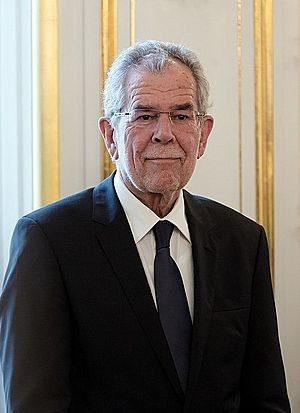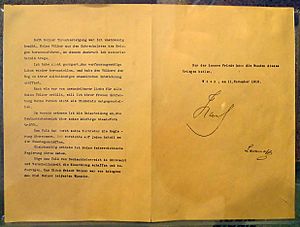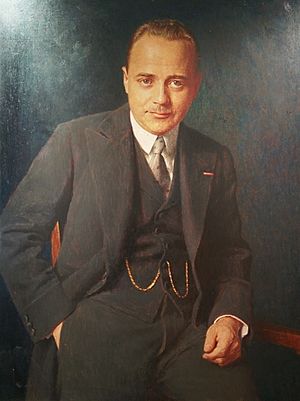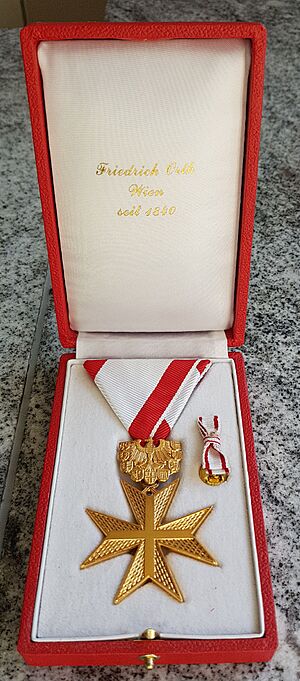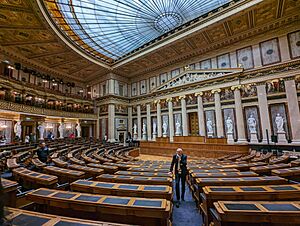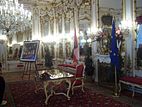President of Austria facts for kids
Quick facts for kids President of Austria |
|
|---|---|

|
|
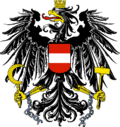
|
|
| Style | Mr. President His Excellency |
| Member of | Presidential Chancellery |
| Seat | Leopoldine Wing, Hofburg Imperial Palace Innere Stadt, Vienna |
| Nominator | Political parties or self-nomination |
| Appointer | Direct popular vote
sworn in by the Federal Assembly
|
| Term length | Six years,
renewable once consecutively
|
| Constituting instrument | Constitution of Austria (1960) |
| Formation | Creation: 10 November 1920 Restoration: 27 April 1945 |
| First holder | Michael Hainisch |
| Abolished | Anschluss: 13 March 1938 (later restored) |
| Succession | Line of succession |
| Salary | €349,398 annually |
The President of Austria (in German: Bundespräsident der Republik Österreich) is the head of state of the Republic of Austria. This means they are the highest-ranking official in the country.
The role of president was created in 1920. This happened after the Austro-Hungarian Empire and the Habsburg monarchy ended in 1918. The president took over from the emperor of Austria. The president's power has changed a lot over time. At first, the president had very little power. Later, the president gained a lot of power. But this power was taken away again in 1934 when Austria became a dictatorship.
In 1938, Nazi Germany annexed Austria, and the presidency was completely removed. After Allied forces freed Austria in 1945, the country's original laws were brought back. The president's office was also restored. Even though the president got back a lot of power, they chose to have a more symbolic role. This allowed the Chancellor to become the main leader of the government.
Since 1951, when people started voting directly for the president, most presidents have been from the Social Democratic Party or the People's Party. The current president, Alexander Van der Bellen, is an exception. He was supported by the Green Party.
The president's most important job is to choose the chancellor, vice chancellor, and ministers. These people together form the Cabinet of Austria. The president also signs new laws, appoints judges, and signs international agreements. They also have many ceremonial duties. The president can also remove the chancellor or the Cabinet. They can also dissolve the National Council (a part of parliament). However, these powers are rarely used. The president is the highest-ranking person in Austria.
The president's office and home are in the Hofburg Imperial Palace in Vienna. Specifically, they are in the Leopoldine Wing of the palace.
History of the Austrian Presidency
How the Office Began
Before World War I ended, Austria was part of the large Austro-Hungarian Empire. An emperor was the head of state and government. The empire started to break apart in late 1917. By 1918, it had split into several independent countries.
As the emperor lost power, members of the parliament from the German-speaking parts of the empire formed a new assembly. This was on October 21, 1918. On October 30, they declared the creation of German-Austria. This was their temporary constitution. They also chose three co-leaders, including Karl Seitz, and created a State Council to run the government. For about two weeks, the old empire and German-Austria existed at the same time.
On November 11, Emperor Charles I stepped back from government. He did not officially give up his title, hoping to return later. But the next day, the National Assembly declared German-Austria a republic. The monarchy officially ended in April 1919 with the Habsburg Law. Charles I was then removed from his position and sent away.
The State Council took over the emperor's remaining powers. The three assembly leaders became the country's collective head of state.
Creating the President's Role
On March 4, 1919, the Constituent National Assembly met. This was the first parliament elected by all citizens. They named Seitz as their chairman. On March 15, the National Assembly ended the State Council. Seitz then became the sole head of state. They began writing a new constitution that year.
The Christian Social Party wanted a president with strong powers, like the president in Germany at the time. But the Social Democratic Worker's Party worried this would be like having another emperor. They preferred a group of leaders as head of state. In the end, they agreed on a compromise. They created a president's office that was separate from the parliament but had very little power.
On October 1, the Federal Constitutional Law was approved. This was the main part of the new constitution. It became active on November 10. This made Seitz the president in all but name. The new constitution said the president would be chosen by the Federal Assembly. This assembly is a joint meeting of both parts of the Parliament. On December 9, 1920, the Federal Assembly elected Michael Hainisch as Austria's first official president.
The First Republic Era
The government system created by the new constitution was not very popular. This led to more support for the Heimwehr movement. This group wanted a system with a stronger president. On December 7, 1929, the constitution was changed. This gave the president much more power. The president's term was also extended to six years. The first direct election for president was planned for 1934. However, due to money problems from the Great Depression, all parties agreed to cancel the election. Instead, Wilhelm Miklas was re-elected by the Federal Assembly.
Three years later, Engelbert Dollfuss and the Fatherland Front ended Austria's parliamentary system. They officially canceled the constitution on May 1, 1934. A new, authoritarian government was put in place. This system gave power to the chancellor, not the president. Miklas lost the power he had gained in 1929. But he agreed to stay on as a symbolic leader to keep things stable. He remained in office until March 13, 1938. This was the day Nazi Germany took over Austria, and Austria lost its independence.
The Second Republic Era
When Austria became an independent country again on April 27, 1945, leaders decided not to write a new constitution. Instead, they went back to the 1920 constitution, with the changes made in 1929. This was done to quickly establish a democratic government. They were also worried that long discussions might cause the Red Army, which was in Vienna, to take control.
The restored constitution still included the rule for people to directly elect the president. However, after the November 1945 election, the Federal Assembly temporarily stopped this rule. They installed Karl Renner as president on December 20. This temporary change was mainly due to a lack of money. Starting with the 1951 election of Theodor Körner, all presidents have been elected directly by the people.
Since Austria became a republic again, presidents have taken a less active role in daily politics. They are usually not the main focus of the news, except during elections. One exception was Kurt Waldheim. He faced controversy when his past service in the German army was revealed. Another exception was Thomas Klestil. He tried to play a more active political role. He wanted the main political parties to stay in power together. He also wanted to represent Austria in the European Council, but he did not succeed in these efforts.
Alexander Van der Bellen (who is linked to the Green Party) became the first president not from the two main parties. He was also the first president to remove a chancellor and an entire Cabinet. This happened because the parliament voted against them.
How the President is Elected
Election Process
The President of Austria is chosen by a public vote for a six-year term. A president can only serve two terms in a row. All Austrian citizens aged 16 and older who can vote in general elections can vote for president.
Until October 1, 2011, members of royal families (like the House of Habsburg) could not run for president. This was to prevent the monarchy from returning. This rule has since been removed. Anyone who can vote in parliamentary elections and is at least 35 years old can now run for president.
The president is elected using a two-round system. This means if no candidate gets more than 50% of the votes in the first round, there is a second vote. Only the top two candidates from the first round can run in the second round. However, the constitution allows the group that nominated one of these two candidates to choose a different candidate for the second round. If only one person runs for president, people vote to either accept or reject that candidate in a referendum.
While in office, the president cannot be part of any other elected group or hold any other job.
The Oath of Office
Article 62 of the Austrian Constitution says that the president must take an oath when they start their job. This happens in front of the Federal Assembly. They can add a religious statement if they wish.
I solemnly swear that I will faithfully observe the Constitution and all the laws of the Republic and fulfill my duty to the best of my knowledge and conscience.
Powers and Duties of the President
The president's powers and duties are set out in the Federal Constitutional Law. Other powers can come from laws, traditions, or past actions.
Most actions by the president need a request and/or a second signature to become official. Requests are made when the president decides to act. Second signatures confirm that the president has signed the act and that it follows all constitutional rules. The person who gives the second signature is also responsible for carrying out the act.
| Action | Needs a Request | Needs a Second Signature |
|---|---|---|
| Executive Powers | ||
| Appointing a Chancellor | No | Chancellor |
| Removing the Chancellor | No | No |
| Appointing a Cabinet | Chancellor | Chancellor |
| Dismissing the Cabinet | No | No |
| Appointing a Minister or Secretary of State | Chancellor | Chancellor |
| Removing a Minister or Secretary of State | Chancellor (unless enforcing a court decision) | Chancellor |
| Appointing Federal Officers | Competent Minister | Competent Minister |
| Issuing Directives as Commander-in-Chief | Unclear | Unclear |
| Legislative Powers | ||
| Issuing Emergency Decrees | Cabinet | Chancellor |
| Dissolving the National Council | Cabinet | Chancellor |
| Dissolving a State Legislature | Cabinet | Chancellor |
| Signing Bills into Law | Chancellor | Chancellor |
| Calling a Constituent Session of the National Council | Cabinet | Chancellor |
| Calling a Session of the National Council | Cabinet | Chancellor |
| Calling an Extraordinary Session of the National Council (discretionary) | No | No |
| Calling an Extraordinary Session of the National Council (compulsory) | Cabinet, National Council or Federal Council | No |
| Adjourning Sessions of the National Council | National Council | No |
| Ordering a Public Vote (Plebiscite) | Cabinet | Chancellor |
| Calling a Session of the Federal Assembly | Cabinet | Chancellor |
| Judicial Powers | ||
| Appointing Justices of the Supreme Court of Justice and the Supreme Administrative Court | Cabinet | Chancellor |
| Appointing Justices of the Constitutional Court | Cabinet, National Council and Federal Council | Chancellor |
| Enforcing Constitutional Court Decisions (federal level) | Constitutional Court | No |
| Enforcing Constitutional Court Decisions (state level) | Constitutional Court | Constitutional Court |
| Presidential Clemency | Minister of Justice | Minister of Justice |
| Diplomatic Powers | ||
| Signing Treaties | Cabinet | Chancellor |
| Allowing State Cabinets to Make Treaties with Other Countries | State Cabinet | Governor |
| Receiving Foreign Representatives | Minister of Foreign Affairs | Minister of Foreign Affairs |
| Approving the Appointment of Consuls | Minister of Foreign Affairs | Minister of Foreign Affairs |
| Appointing Consular Representatives | Minister of Foreign Affairs | Minister of Foreign Affairs |
Executive Powers
Appointing the Cabinet
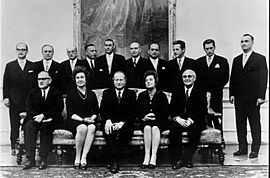
The president chooses the chancellor, the vice chancellor, and the ministers. These people together form the Cabinet of Austria.
A new National Council (the main part of parliament) is elected at least every five years. After an election, the president usually asks the leader of the party that won the most seats to form a new Cabinet. In theory, the president could choose any adult citizen who can be elected to the National Council as chancellor. However, the National Council can vote to remove the chancellor, a minister, or the whole Cabinet at any time. The president must remove any minister the National Council wants gone. This means the chancellor must be accepted by the National Council and keep its trust.
If no party wins more than half the seats (which is common), the leader of the largest party looks for a smaller party to work with. They want to create a stable Cabinet that the National Council will support. This process starts with "exploratory discussions" with all parties, which can take weeks. The chancellor candidate looks for the party most willing to compromise. Once a partner is found, they start more serious "coalition negotiations." This usually takes several months. The goal is to create a plan for the government, a contract between the parties, and a list of ministers. The leader of the smaller party usually becomes the vice chancellor and gets another ministry.
After negotiations, the winning party's leader gives the list of ministers to the president. The president can accept or reject it. If accepted, the new Cabinet is appointed and sworn in. If rejected, the president might ask for changes, ask someone else to form a Cabinet, or call for new elections.
Only three times has a president refused to appoint a Cabinet member. Karl Renner refused to re-appoint a minister suspected of corruption. Theodor Körner rejected a request to include a far-right party member in the Cabinet. Thomas Klestil refused to appoint someone who had been charged with a crime and another who had made extreme comments.
Removing the Cabinet
The president can remove the chancellor or the entire Cabinet whenever they want. However, individual Cabinet members can only be removed by the president if the chancellor asks for it. So far, a whole Cabinet has never been removed against its will. President Wilhelm Miklas did not use this power when Chancellor Engelbert Dollfuß ended the Constitution to create a dictatorship.
A minister has only been removed against their will once. This happened when Chancellor Sebastian Kurz asked President Alexander Van der Bellen to remove Interior Minister Herbert Kickl. After a political scandal, Kickl tried to appoint someone close to him to a powerful security role. President Alexander Van der Bellen refused to approve this appointment.
The president is the only person who can legally remove any Cabinet member (including the chancellor) from office. Even if a Cabinet member resigns or is voted out, the president must officially remove them.
Appointing Other Officials
Legally, the president appoints all federal officials, not just Cabinet members. This includes all military officers and soldiers, all judges, and all regular government workers. However, this power is usually given to the ministers and their staff. The president still has the right to personally appoint the top leaders of federal agencies.
The governors of the states are both the chief leaders of their state government and representatives of the national Cabinet. So, the president swears in all governors after they are elected by their State Legislature.
Legislative Powers
Signing Bills into Law
The president signs all bills to make them laws. Signing bills is a duty, not a choice. It's not like a presidential veto in the United States. When signing bills, the president must check if the law was passed correctly according to the constitution. If not, the president must refuse to sign, which stops the bill. All federal bills, both regular and constitutional, must be signed by the president to become active.
The president usually does not check if a law follows constitutional law. That job belongs to the Constitutional Court. Some people believe the president can refuse to sign if a law is clearly against the constitution. President Heinz Fischer once refused to sign a bill that would have punished people for past actions. This is the only time a president has refused to sign a bill.
Once a bill is introduced in Parliament, it must pass the National Council and be approved by the Federal Council to become law. After it's approved, the bill goes to the chancellor, who gives it to the president. After the president signs the bill, the chancellor also signs it and then publishes it. This makes the bill an official law.
Dissolving the National Council
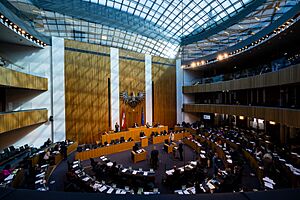
The president can dissolve the National Council if the Cabinet asks, but only once for the same reason. If the president ends the parliament's term, the National Council is immediately dissolved and cannot function. However, a special committee of the National Council remains as an emergency group until a new National Council is elected. If the National Council dissolves itself, the old one continues to meet until a new one is chosen.
So far, only President Wilhelm Miklas has used this power. He did so after the Christian Social Party lost its coalition partner and parliament's support.
Dissolving State Legislatures
The president can dissolve any State Legislature if the Cabinet asks and the Federal Council agrees. However, the president can only do this once for the same reason. The Federal Council must agree with a two-thirds majority vote. The representatives from the state whose legislature is being dissolved cannot vote.
Dissolving a State Legislature is seen as interfering with federalism. This is because national authorities are stepping into the states' self-governance. This power has never been used.
Emergency Decrees
The president can issue emergency decrees during a crisis. The Constitution states:
To prevent serious harm to the public, when the National Council is not meeting and cannot be called quickly, the president can issue temporary laws. This must be at the request of the Cabinet and with the approval of a special committee of the National Council.
Emergency decrees cannot change the Constitution or important laws. As soon as the National Council meets again, it must approve or cancel any active emergency decrees. The power to issue decrees has never been used.
Other Legislative Powers
The president can call and end sessions of the National Council. If the Cabinet or one-third of the National Council or Federal Council members ask, the president must call a session of the National Council. The president can also call a session of the Federal Assembly. Finally, the president can order a binding (Volksabstimmung) or non-binding (Volksbefragung) plebiscite (public vote).
Judicial Powers
Enforcing Constitutional Court Decisions
The president is responsible for carrying out decisions made by the Constitutional Court. This applies if the enforcement is not handled by regular courts. The Court itself asks the president to enforce its decisions.
The Constitution gives the president broad powers to enforce these decisions. The president can give orders to any federal or state authority as part of these enforcements.
Appointing Judges
The president appoints the president, vice president, six other judges, and three substitute judges of the Constitutional Court. This is done based on the Cabinet's recommendation. Additionally, the president appoints three judges and two substitute judges based on the National Council's recommendation. They also appoint three judges and one substitute judge based on the Federal Council's recommendation.
The president also appoints all judges of the Supreme Court of Justice and the Supreme Administrative Court. This is done based on the Cabinet's recommendation. However, the Cabinet can only choose from a list of judges nominated by the Courts themselves.
Presidential Clemency
The president has the power to grant clemency. This includes pardons, changing sentences, and reducing punishments. According to the Constitutional Court, a presidential pardon not only cancels the sentence but also removes the conviction itself. The president can also remove criminal record entries or limit who can see a person's criminal record.
People who want clemency must ask the Ministry of Justice. The minister then approves or denies the request. If approved, it goes to the president. The president usually accepts the minister's decision. While the president can always deny clemency, they cannot grant it without a request from the Minister of Justice.
Diplomatic Powers
The president is Austria's chief diplomat. They can negotiate and sign treaties with other countries. They also receive foreign representatives, approve the appointment of consuls, and personally appoint consular representatives. Treaties that change or add to existing laws must be approved by the National Council.
When Austria joined the European Union, President Thomas Klestil and Chancellor Franz Vranitzky disagreed on who should represent Austria in the European Council. The chancellor eventually took on this role. Klestil argued that he had only given his power to the chancellor.
Military Powers
The president is the commander-in-chief (Oberbefehlshaber) of the Austrian Armed Forces. This is one of the less clear presidential powers. The exact extent of the president's authority as commander-in-chief is open to interpretation.
Even though the president outranks the minister of defense and all military personnel, their military authority usually needs a second signature or a request from the Cabinet. This means this power can only be used with the Cabinet's cooperation.
Since no president has ever used this power, there are no past examples to define it. Daily military operations are managed by the minister of defense. The minister is called the commander (Befehlshaber) of the Armed Forces by the Constitution. Defense policy and major decisions about using the military are usually made by the entire Cabinet.
As commander-in-chief, the president takes over the role of the emperor of Austria. The emperor was the head of the Austro-Hungarian military. After the Habsburg monarchy fell, a committee of the new National Council became the main decision-making body for the Armed Forces. In 1929, the Christian Social Party moved this top military authority from the committee to the president.
The president also grants official papers to officers, but this is not part of their role as commander-in-chief.
Ceremonial Duties
The president has other powers and duties that are typical for a head of state. These include creating and giving out honorary titles. They also have the symbolic right to make children born outside of marriage legally legitimate if their parents ask.
The president also gives out the Decorations of Honour for Services to the Republic of Austria. This is Austria's most respected state award. It is given for outstanding achievements, especially in politics, science, and culture. This is done at the request of the Cabinet. There are 15 levels of these decorations, from the Bronze Medal to the Grand Cross. The president automatically receives the Grand Cross when they take office.
Another special power is giving the Promotio sub auspiciis Praesidentis rei publicae. This is a golden ring, the highest honor for students earning a doctoral degree.
The President's Time in Office
Immunity from Prosecution
The president is generally protected from any type of criminal procedures. The president can only be prosecuted with the clear permission of the Federal Assembly. If a government agency wants to prosecute the president, it must ask the National Council. If the National Council agrees, the Federal Assembly is called to meet.
The Constitution does not say that a criminal conviction automatically removes the president from office. However, a prison sentence would certainly make the president unable to do their job. This would lead to a loss of all presidential authority.
Accountability of the President
Political Accountability
The usual way to remove a president from office is through a public vote (plebiscite). Since the people elect the president, the people can also remove them.
This process starts with the National Council voting to call the Federal Assembly. The Federal Assembly then considers removing the president. This vote needs a two-thirds majority and at least half of all National Council members must be present. If this vote passes, the president is immediately unable to do their job. Once the Federal Assembly meets, it decides whether a public vote should happen.
If the public vote supports removing the president, the president is removed. If the public vote opposes removal, a new parliamentary election is triggered, and the National Council is automatically dissolved.
Legal Accountability
The president can be impeached (accused of wrongdoing) before the Constitutional Court. This happens if they violate constitutional law.
This process starts with a vote by either the National Council or the Federal Council. If the vote passes, the Federal Assembly must meet. The Federal Assembly then considers impeaching the president. A two-thirds majority and at least half of all members from both the National Council and the Federal Council are needed to start the impeachment process.
If the Federal Assembly votes to impeach, it acts as the accuser before the Constitutional Court. If the Court finds the president guilty of violating the Constitution, the president is removed from office. If the president is found guilty of only a minor offense, they stay in office and are simply given a warning.
Who Takes Over?
The Constitution does not create a vice president position. If the president is temporarily unable to do their job (for example, due to surgery, illness, or a trip abroad), the chancellor takes over for up to twenty days. The chancellor does not get a special title like "acting president" during this time.
The powers and duties of the presidency go to the Presidium of the National Council in three situations:
- If the twenty-day period with the chancellor ends, the Presidium takes over on the twenty-first day.
- If the president's office becomes empty because the president dies, resigns, or is removed, the Presidium takes over immediately.
- If the president cannot do their job because the National Council has called the Federal Assembly to consider removing the president through a public vote, the Presidium also takes over immediately.
When the three presidents of the National Council (who form the Presidium) exercise presidential powers, they act together as one body. If their votes are tied, the highest-ranking president makes the final decision.
President's Salary
The president receives an annual salary of €349,398. The chancellor earns €311,962 per year. This salary is quite high compared to leaders of much larger countries. For example, the chancellor of Germany (€251,448), the president of France (€179,000), and the prime minister of the United Kingdom (€169,284) receive lower salaries.
Where the President Works
The president's main home and workplace are in the Leopoldine Wing of the Hofburg Imperial Palace. This palace is in the Innere Stadt area of Vienna. The Leopoldine Wing is sometimes called the "Presidential Chancellery" (the Office of the President). However, the president does not actually live in the Hofburg. They keep their own personal home.
The Hofburg is an old building from the time of the emperors. It was built in the 13th century under Holy Roman Emperor Leopold I. After the monarchy ended and the republic was formed, democratic institutions intentionally kept their distance from royal buildings. So, the president's first workplace was actually the chancellery building. After heavy bombing during World War II, the chancellery building was badly damaged and could not be used. So, the president had to find a new workplace. The first president of the Second Republic, Karl Renner, chose the Leopoldine Wing. He chose it because its design was greatly influenced by Empress Maria Theresia, who was very popular at the time. The chancellery building was later rebuilt and is now where the chancellor works.
Today, the Leopoldine Wing houses the offices of the Presidential Chancellery on its second and third floors. Besides the Hofburg, the president also has a summer residence in Styria called the Mürzsteg Hunting Lodge. Former President Heinz Fischer promised to sell the building during his campaign. However, he and his successor have used the lodge to host guests and foreign leaders.
Protection for the President
The sitting president is legally protected by several criminal laws. The most important one is § 249 of the Criminal Code:
Anyone who attempts to remove the president by force or threats, or uses these methods to force or prevent the president from doing their job, will be imprisoned for up to ten years.
The presidential title "Bundespräsident" is protected by the constitution. No one else can use it, even if combined with other words.
Office of the President
The Office of the President (Präsidentschaftskanzlei) is a government agency that works directly under the president. It helps the president with their powers and duties. It also helps the president communicate with politicians, diplomats, and citizens. The office manages all other daily tasks related to the presidency. The agency includes various clerks, political advisors, legal advisors, spokespeople, and the president's adjutant (an army officer who protects the president). The Office of the President is located in the Leopoldine Wing of the Hofburg Imperial Palace.
See also
 In Spanish: Presidente de Austria para niños
In Spanish: Presidente de Austria para niños


